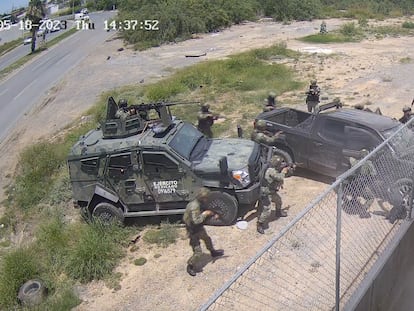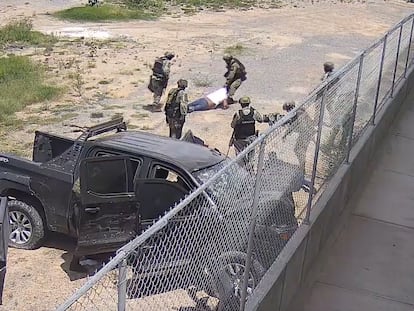Autopsies of military killings in Mexico’s Nuevo Laredo: Fourteen shots and five deaths
Forensic experts who studied the bodies of civilians who allegedly died at the hands of soldiers concur with the lieutenant’s claim of a shootout with gang members, despite questions raised by video footage of the incident

The autopsies of five civilians allegedly killed by the military in unclear circumstances in the Mexican town of Nuevo Laredo on May 18 offer new insights into an incident that EL PAÍS has been investigating through analysis of video footage and testimonies provided by the soldiers involved.
The forensic and mechanical injury studies, part of an investigation by the Attorney General’s Office (FGR) to which this newspaper has had access, show that the civilians sustained a total of 14 bullet wounds. Four out of the five died from the bullet wounds, one of them in the hospital. The fifth, while also wounded by the gunshots, died from injuries caused a few minutes earlier when the pickup truck they were traveling in at high speed crashed into a wall following a chase.
Although the events date back to May 18, the case made headlines on June 6, when this newspaper released video footage from a supermarket security camera in which the military appeared to shoot at the five unarmed men, who had been placed against the wall. The men were all alleged members of a criminal gang and soldiers are seen removing weapons and tactical equipment from the crashed vehicle, including a Barrett .50 caliber rifle capable of piercing through armor.
Despite images in which at least three soldiers are observed shooting at the five men, the expert reports concluded that the injuries on the bodies were “consistent” with the account of events given by the military officer in charge of the operation, Lieutenant José Luis N. In his report, he stated that the five men had died after being shot by their own colleagues who were attempting to rescue them, resulting in a shootout between gang members and soldiers.
In the report, of which this newspaper has a copy, the lieutenant stated that he and his men were disarming the civilians when the latter’s colleagues showed up and began shooting at them “in an attempt to rescue their own personnel.” The military responded with gunfire of their own. Meanwhile, the detained civilians were trying to recover their weapons, according to this version of events. When the shooting was over, the soldiers realized that four of the five detainees were dead and one more was in “critical condition” as a result of the crossfire.
But the fact that the five civilians suffered gunshot wounds while the soldiers remained unscathed raises questions about the claim. The trajectories of some of the bullets are also inconsistent with this account: one man, Jorge Antonio Colector Pineda, received a single shot in the top of the head. The coroner who signed the reports indicated in all cases that the shots were fired from a “long distance,” although the exact number of meters is not determined.
The report offers information about the deceased. The youngest was 23 years old and the oldest, 37. Clinton Alex Bucha, who died in the hospital, was originally from Honduras and lived in Nuevo Laredo with his partner. The rest were Mexican, two from Nuevo Laredo, one from Veracruz and one from Guerrero. All of them were covered in tattoos featuring skulls, marijuana leaves and the names of meaningful people in their lives.
When the case came to the attention of Mexican President Andrés Manuel López Obrador, he avoided talk of an undeclared war in the territory and instead supported the theory of an isolated event. Trying to distance himself from the two previous governments, under whose terms there were dozens of cases of extrajudicial killings, torture and forced disappearances perpetrated by members of the Navy and the Army, López Obrador usually frames such cases as one-off mistakes.
The case made waves in Nuevo Laredo, not because of the possible executions, but because of the number of alerts it generated on social media that day. The street action that ended with the car crash and the alleged killings rocked the south of the city. In videos shared on social media, local residents are seen lying on the ground, sheltering from the bullets.
Sign up for our weekly newsletter to get more English-language news coverage from EL PAÍS USA Edition
Tu suscripción se está usando en otro dispositivo
¿Quieres añadir otro usuario a tu suscripción?
Si continúas leyendo en este dispositivo, no se podrá leer en el otro.
FlechaTu suscripción se está usando en otro dispositivo y solo puedes acceder a EL PAÍS desde un dispositivo a la vez.
Si quieres compartir tu cuenta, cambia tu suscripción a la modalidad Premium, así podrás añadir otro usuario. Cada uno accederá con su propia cuenta de email, lo que os permitirá personalizar vuestra experiencia en EL PAÍS.
¿Tienes una suscripción de empresa? Accede aquí para contratar más cuentas.
En el caso de no saber quién está usando tu cuenta, te recomendamos cambiar tu contraseña aquí.
Si decides continuar compartiendo tu cuenta, este mensaje se mostrará en tu dispositivo y en el de la otra persona que está usando tu cuenta de forma indefinida, afectando a tu experiencia de lectura. Puedes consultar aquí los términos y condiciones de la suscripción digital.
More information
Archived In
Últimas noticias
Welcome to the post-religion era: The idea of Christianity as the absolute truth has become obsolete
‘I thought you would like it’: The risky sexual practice popularized by TV shows and TikTok
The digitalization of tourism: ‘They promise experiences and gave us the worst possible one’
Mexican peso defies uncertainty with forecasts of a new period of stability in 2026
Most viewed
- Sinaloa Cartel war is taking its toll on Los Chapitos
- Reinhard Genzel, Nobel laureate in physics: ‘One-minute videos will never give you the truth’
- Oona Chaplin: ‘I told James Cameron that I was living in a treehouse and starting a permaculture project with a friend’
- Why the price of coffee has skyrocketed: from Brazilian plantations to specialty coffee houses
- Silver prices are going crazy: This is what’s fueling the rally











































